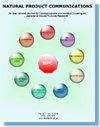LC-MS/MS Profiling, Antioxidant Potential and Cytotoxicity Evaluation of Citrus reticulata Albedo
IF 1.4
4区 医学
Q4 CHEMISTRY, MEDICINAL
引用次数: 0
Abstract
Background: The massive production of agro-industrial waste has become a global concern. Approximately 3.6 million tons of citrus waste are disposed of annually after processing, despite most bioactive molecules being found in fruit peels. Objectives/methodology: This work explored the biochemical and carbohydrate polymer profile of methanolic extract of the soft, spongy Citrus reticulata ( C. reticulata) albedo through proximate analysis, antioxidant and scavenging potential analysis, carbohydrate analysis, antioxidant enzyme and genotoxicity analysis, which were further quantified by MTT (3-[4,5-dimethylthiazol-2-yl]-2,5 diphenyl tetrazolium bromide) assay and Fourier transform infrared spectroscopy (FTIR) analysis. Results: The results revealed that the citrus albedo comprised an ample amount of ash (3.30 g/100柑橘网纹叶的 LC-MS/MS 分析、抗氧化潜力和细胞毒性评估
背景:农用工业废物的大量产生已成为全球关注的问题。尽管大多数生物活性分子都存在于果皮中,但每年约有 360 万吨柑橘加工后的废弃物被丢弃。目标/方法:这项研究探索了软海绵柑橘(C. reticulata)反皮层甲醇提取物的生物化学和碳水化合物聚合物特征。通过近似物分析、抗氧化和清除潜能分析、碳水化合物分析、抗氧化酶和遗传毒性分析,并通过 MTT(3-[4,5-二甲基噻唑-2-基]-2,5-二苯基溴化四氮唑)测定法和傅立叶变换红外光谱(FTIR)分析进一步对其进行量化。结果显示结果表明,柑橘反照素含有大量灰分(3.30 克/100 克鲜重(FW))、水分(52.67 克/100 克 FW)、纤维(30.80 克/100 克 FW)、脂质(5.58 克/100 克 FW)、蛋白质(9.碳水化合物含量,即果胶(18.5 毫克/克干重)、葡萄糖胺(5.05 毫克/克干重)、麦芽糖(6.5 毫克/克干重)、D-木糖(35.5 毫克/克干重)、纤维素(12.2 毫克/克干重)、总可溶性糖(13.5 毫克/克干重)、淀粉(29% w/w)。抗氧化酶表现出极高的活性(超氧化物歧化酶为 23.06 IU/mL,过氧化氢酶为 37.10 IU/mL,过氧化物酶为 1.27 IU/mL)。当使用浓度为 100 毫克/毫升时,柑橘白皮中的生物活性分子显示出最大的总酚含量(TPC)(2.30 毫克没食子酸当量(GAE)/克干重)、总黄酮含量(TFC)(1.71 毫克槲皮素当量(QE)/克干重)和清除潜力(50.67% 的抑制率)。傅立叶变换红外光谱和液相色谱-质谱法(LC-MS)的研究结果表明,柑橘白皮含有丰富的多糖,包括果胶、葡萄糖胺和抗氧化剂,如咖啡酸、槲皮苷、柚皮苷、橙皮苷和白藜芦醇。此外,MTT 试验表明,肝母细胞瘤细胞株(HepG2)在暴露于不同浓度的网纹叶蝉提取物 72 小时后出现凋亡。结论这些研究结果表明,柑橘反照素是一种潜在的肝细胞癌化疗药物。
本文章由计算机程序翻译,如有差异,请以英文原文为准。
求助全文
约1分钟内获得全文
求助全文
来源期刊

Natural Product Communications
工程技术-食品科技
CiteScore
3.10
自引率
11.10%
发文量
254
审稿时长
2.7 months
期刊介绍:
Natural Product Communications is a peer reviewed, open access journal studying all aspects of natural products, including isolation, characterization, spectroscopic properties, biological activities, synthesis, structure-activity, biotransformation, biosynthesis, tissue culture and fermentation. It covers the full breadth of chemistry, biochemistry, biotechnology, pharmacology, and chemical ecology of natural products.
Natural Product Communications is a peer reviewed, open access journal studying all aspects of natural products, including isolation, characterization, spectroscopic properties, biological activities, synthesis, structure-activity, biotransformation, biosynthesis, tissue culture and fermentation. It covers the full breadth of chemistry, biochemistry, biotechnology, pharmacology, and chemical ecology of natural products.
Natural Product Communications is a peer reviewed, open access journal studying all aspects of natural products, including isolation, characterization, spectroscopic properties, biological activities, synthesis, structure-activity, biotransformation, biosynthesis, tissue culture and fermentation. It covers the full breadth of chemistry, biochemistry, biotechnology, pharmacology, and chemical ecology of natural products.
 求助内容:
求助内容: 应助结果提醒方式:
应助结果提醒方式:


